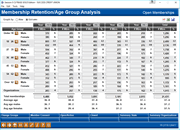Analyzing Member Retention by Age Groups
| Screen ID: | IMBRAN-01 | 
|
| Screen Title: | Membership Analysis | |
| Panel ID: | 3715 | |
| Snap Shot: | ¨
As of Month End þ Right Now |
|
| Tool Number: | 508 | |
| Click here to magnify |
Access this screen by selecting Tool #508 Member Retention by Age Group.
NOTE: Because this dashboard uses current month files, the data on this report will not be static.
Export and Common Bonds Using Selectable Data Points
Any data point that is selectable (differentiated by a button-like highlight, also note that when hovering over a clickable data point the cursor adjusts to allow selection) will allow you to select to either Export the data to a file, or to use Common Bonds to view additional data sets.
Additional Dashboard Links
Dashboard Tips – Questions to Ask When Comparing a Dashboard with Another Dashboard or Report
SEE ALSO: Knowing Your Members Relationship Management Tools
How does your credit union attract and retain members from different age groups?
Instead of analyzing account retention data as the Account Retention by Age Group Dashboard, this dashboard analyzes membership data by age group and gender.
“Our membership is getting older every day. Young people just aren’t joining at the rate they did back in the good old days. We are losing more members than we are attracting.”
Are you sure that’s really true? You might be surprised if you analyze the data. The problems with remembering the good old days, is that your memory doesn’t always match the reality of the past. And besides, is what was “good” yesterday really relevant to your future anymore?
Credit unions often say that their membership is getting older and that young people are not interested in what they have to offer right now. So how do you prove or disprove this theory? In 1995, did you attract younger members than you are attracting today? What percentage? Does it have anything to do with the age of the member, or a change in the energy of the credit union from 1995 to today? What are the real numbers?
The analysis just got a whole lot easier. This tool lets you see a breakdown showing the ages of your members when they joined the credit union. You can compare several years next to each other, so you can see if the members joining in 1995 were really younger than the new members who are joining today.
This analysis also includes information on retention of these members, allowing you to analyze data on how many members are still active based on the year that they joined the credit union, the net loss of membership during the given year, and the percentage of members you retained in a given year.
Retention and additional data can be accessed via the lookups next to each age range (retention by age range), and through Summary Stats (retention by gender) and Summary Organizations (retention across organizational accounts).
|
Open Memberships |
Includes all memberships from MASTER and MSHIST with a membership opened date in each of the displayed years. (This option is unique in that is analyzes both memberships that have remained open (since the selected year) and also those that have since closed (since the selected year). Use this to analyze what age members were when they came to your credit union, whether they stayed with you or not. |
|
Active Memberships |
Includes only memberships from MASTER with an opened date in each of the displayed years. These memberships are still active with your credit union and have not closed. In other words, use this to analyze only the members you still have. (Also see note above about Open Memberships selection.) |
|
Closed Memberships |
Includes only closed memberships from MSHIST with a membership opened date in each of the displayed years. Use this to analyze the age members were when they left to your credit union. Also see note above about Open Memberships selection.) |
Keep in mind that this analysis is not intended to show all of your credit union’s memberships, only those with open dates in the specified years.
-
Use the year fields in the top of the screen to enter any years going back to when your credit union opened (assuming your member data is clean even for your long-time members). Use Enter to refresh the screen.
Average Age of Members
At the bottom of the screen, view the average age of all your members, as well as the average age of males and females, across all years selected.
Buttons
|
Buttons |
Description |
|
Use this to change the age ranges in the Age Groups column. |
|
|
Open/Active and Closed |
Use Open/Active and Closed to toggle the display between the two options (note the blue title in the upper-right corner of the screen). In all cases, the system uses the membership opened date to determine under which year the membership is counted. |
|
View retention and additional information about open and closed accounts by gender across the credit union. (To view by age range, click the lookup next to the age range.) |
|
|
View retention and additional information about open and closed accounts of organizational accounts and unclassified accounts (including accounts without gender) across the credit union. |